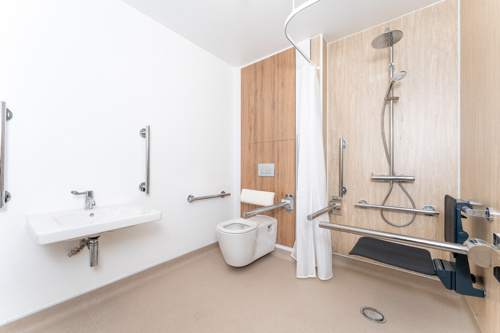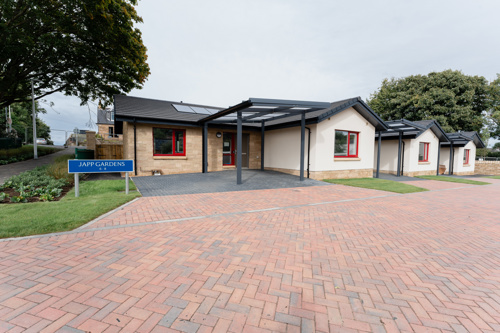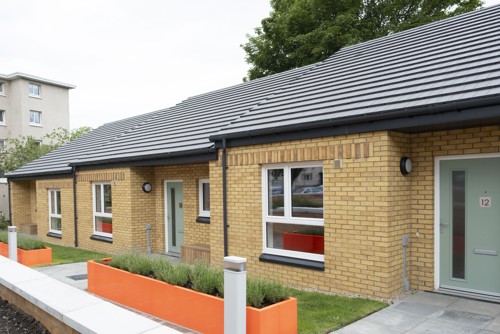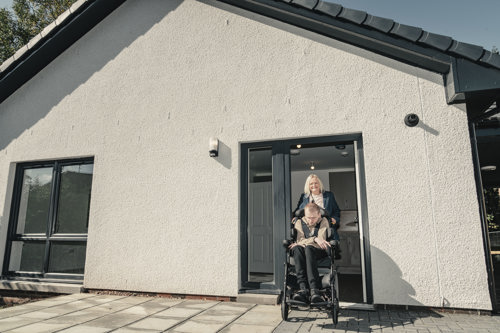Scotland Housing Awards 2025
Read all the shortlisted entries into this award category, excellence in accessibility and inclusion, at the Scotland Housing Awards (SHA) 2025 and find out who won the award on the night.
As we get older the need for accessible housing to support independent living is more important than ever. This award recognises housing organisations whose new build design or retrofit projects and approaches enhance accessibility, inclusion and customers ability to live in their own home safely and as independently as possible.
This award was sponsored by Horizon Housing.
Winning project name
Japp Gardens
Winning organisation
Falkirk Council
Partner organisation
Falkirk Council Health & Social Care Partnership
Statement of support
Oakbank was an 18-bed care home owned by Falkirk Council, in operation since 1949. A 2015 review by Falkirk’s Health and Social Care Partnership found the facility no longer met modern care standards, including inadequate bedroom sizes, corridor widths, and bathroom facilities. The home was subsequently closed in 2017.
The site is well located with excellent transport links and nearby shops and a restaurant. Given its location and former use, Falkirk Council’s housing department saw a unique opportunity to create a social housing development that could deliver similar social benefits to those previously provided by the care home following the identification of a shortfall in provision of this type of housing being identified in the 2019 Housing Needs and Demands Assessment.

A design brief was developed by the council’s in-house architects and quantity surveyors to explore a mix of accessible housing types, including ambulant flats and fully wheelchair-accessible bungalows. Community consultation was held at Greenpark Community Centre in November 2019. Feedback was supportive, with suggestions such as connecting the development to the adjacent public park and adding footpaths for direct pedestrian access to local amenities. These were incorporated into the final design.
One of the key challenges was ensuring the development was financially viable, particularly given the space requirements of bungalow style homes and the desire to retain the site’s existing trees and greenery. A creative solution was found by using the site’s natural slope to accommodate a three-storey block of ambulant flats that appears as two storeys from the roadside, preserving the skyline and aiding planning approval.
Despite the design team’s best efforts, the project remained financially challenging. However, it was agreed that the quality of the proposal should not be compromised. At this stage, a partnership was formed with Falkirk’s Health and Social Care Partnership, who recognised the strategic and local benefits of the development.

Working together, the teams developed the proposal and secured the necessary funding to deliver the project.
The completed development, named Japp Gardens in honour of long-standing local resident William Japp, includes 28 homes:
- 21 flats in a three-storey block (12 one-bedroom, nine two-bedroom)
- Seven bungalows across two terraces (three one-bedroom, four two-bedroom).
The semi open plan living room, kitchen and dining arrangement is a development of previous projects, and is based on feedback from tenants. The semi open plan arrangement of the principle living spaces improves accessibility and allows greater flexibility of use and suitability for varying disabilities, an complies fully with the Housing for Varying Needs guidance.
The flats are designed as amenity homes with level access and a passenger lift. Each flat includes a wet room and features not typically found in standard council housing such as power-assisted doors in both communal areas and individual entrances. Bedrooms are designed with future adaptability in mind, including walls that can be removed for future modifications such as bathroom access, and electrical points for assistive technologies.
Additionally, residents of the flats benefit from a detached mobility scooter garage equipped with internal charging points. This facility ensures scooters are stored securely and remain charged, while also maintaining fire safety standards within the flatted accommodation.
The bungalows are fully wheelchair-accessible and designed in line with Housing for Varying Needs guidance. Features include:
- Covered car ports with fob-operated automated doors
- Accessible shower rooms
- Kitchens with adjustable-height hobs and sinks
- Raised access to appliances
- Narrow kitchen cabinet doors for easier navigation
- Adaptable whirly gig.
This development represents a forward thinking approach to inclusive housing, offering high quality, adaptable homes that support residents’ independence and wellbeing.
Outcomes and achievements
Japp Gardens exemplifies Falkirk Council’s commitment to inclusive, future-proof housing. This new-build development delivers high-quality, adaptable homes designed to promote independence, wellbeing, and community integration. The project has received overwhelmingly positive feedback from councillors, officers, and tenants, who have praised its thoughtful design and attention to accessibility.
A key strength of the development was its collaborative approach. During construction, the Tenant & Resident Group part of the council’s Housing Asset Management Plan visited the site and provided valuable input. One member, a disabled resident, offered insights ensuring the homes met real life needs.
The impact on tenants has been profound. One resident shared, “It’s easier living and so quiet.” Another commented, “The council have thought about convenience. I’d be housebound if I did not get this bungalow. I like hanging my washing out using the adaptable whirly gig. My car is more accessible, and I don’t need to scrape the windows. The house has made such a difference to my quality of life.”
Japp Gardens stands as a model of inclusive design, demonstrating how thoughtful planning and tenant engagement can transform lives and set new standards in social housing.
Shortlisted entries
West Dunbartonshire Council - Mount Pleasant
Application entry
- Project name: Mount Pleasant
- Lead organisation: West Dunbartonshire Council
- Partner organisation: CCG
Statement of support
Mount Pleasant is an affordable housing development for West Dunbartonshire Council, providing new homes for the over 55s who are looking to downsize. Designed to Housing for Varying Needs and Dementia Design guidance, the homes support ageing in place and provide an inclusive community for residents. The development includes nineteen homes within three blocks of flats, bungalows, and cottage flats arranged around a central community garden and resident’s car park.

An inclusive community
The central garden is visible from each residential block and provides a focus and social hub for residents. It promotes sociability by providing choice. Residents can join in shared activities with their neighbours by joining in with gardening activities – the fully wheelchair accessible garden incorporates social seating surrounded by low level planting borders, used to grow flowers, herbs and vegetables plus a covered seating bench provides a sheltered space to sit during inclement weather.
Alternatively, if residents prefer to step back and observe activity (a preference for some people with dementia) they can sit at their front doors using a bench designed into covered front porches for bungalows, or chat informally across low-level boundary walls between rear gardens.
The local designing out crime officer was consulted throughout the design process, helping to identify ways to ensure the scheme felt safe and secure for the tenants, addressing issues related to overlooking and highly permeable boundaries through architectural interventions.
Excellence in accessibility
To aid orientation and wayfinding across the site, which ageing residents may find more challenging, colour has been utilised – planting boxes and doors to each block are assigned a contrasting and distinct colour to provide landmarks and help identify the location of their home. Front gardens, with their sheltered porches and outdoor benches, also provide space for personalisation to help differentiate each home. Internally, a colour scheme was applied to each floor in the four-storey block, with different tiling, paint, and door colours at each floor, aiding wayfinding and orientation.
Outdoor spaces:
- Paths and roads are clearly delineated for individuals to assist people with visual impairments or perceptual difficulties (such as dementia)
- There are no steps and level changes are managed with gentle ramps
- Manageable garden sizes are easier for older residents to maintain independently.
Indoor spaces:
- Level access thresholds throughout
- Wet rooms instead of traditional bathrooms, future-proofed for adaptations, with step-free showers in wheelchair-accessible house types
- Lift access to flats
- Homes are designed with direct lines of sight from bedrooms to bathrooms and from living rooms to kitchens to aid tenants who develop dementia
- Glass doors in kitchen wall cabinets to help tenants who develop dementia to easily locate items
- Rise and fall worktops within the wheelchair accessible properties ensure that kitchen sinks and hobs are fully adaptable to the height required by individual residents.
Mix of homes
A variety of homes within the development, ranging from one-bed bungalows to two-bed flats, create the opportunity for a diverse resident collective, enriching both the development and the wider community.
Tenant feedback
- "I am so happy in my new home, I was reluctant to leave my larger family home and garden in Dunbarton, however my new house is thoughtfully designed, I have a low maintenance private garden, and I am looking forward to meeting my neighbours around the community garden."
Outcomes and achievements
Accessible homes
Each home is compliant with the Scottish government’s Housing for Varying Needs Guidance, providing accessible homes for residents to age in place.
100 per cent affordable homes
The development is designed for the over 55s enabling them to downsize to more manageable properties within their local area. This targeted approach to a specific demographic helps to build a close knit and resilient community.
A safe and pedestrian prioritised development
The architectural design and landscape planting strategy promotes wayfinding and orientation, putting pedestrian movement at the forefront of the design. Footpaths are clearly marked, and take priority over vehicular routes, ensuring the safe movement of residents between the residential blocks and around the central community garden. The development encourages the use of public transport to access local retail, community and leisure facilities.
Energy efficient homes
The new homes are energy efficient, helping to reduce energy bills and fuel poverty. Each home has an ASHP or MVHR unit, as well as PV panels to generate renewable energy.
Caledonia Housing Association - Better Homes, Brighter Futures
Application entry
- Project name: Better Homes, Brighter Futures
- Lead organisation: Caledonia Housing Association
Statement of support
Our purpose is clear: to provide homes and services that make life better. Accessibility and inclusion are embedded in our strategy, culture, and operations, shaping every decision and home we build.
Our guiding principle, “keep it personal”, ensures that even as one of Scotland’s largest housing associations, we maintain the connections, responsiveness, and trust of a local provider. We design and maintain homes for all ages, abilities, and circumstances – enabling people to live well, independently, and with dignity in communities they are proud to call home.

Accessibility and inclusion in action
The £multi-million regeneration of Bellsmyre in West Dunbartonshire is a prime example of how inclusion drives what we do. This ambitious, multi-phase project is replacing outdated tenement flats with 138 high-quality, energy-efficient homes that meet modern accessibility standards, cut running costs, and provide long-term comfort.
Residents have been central to decisions – shaping proposals, influencing design, and prioritising community needs through consultation and engagement. Our allocations policy gives displaced tenants priority, allowing them to stay close to friends, family, and vital support networks.
The new homes feature adaptable layouts, step-free access, and enhanced insulation to tackle fuel poverty. The regeneration also brings wider benefits – local jobs, apprenticeships, skills training, green spaces, play areas, and community facilities that strengthen neighbourhood cohesion and create long-term social value.
The regeneration is transforming the community, involving multiple partners, illustrating our commitment to building better homes and inclusive futures.
Designing and delivering inclusive homes
Our commitment to accessible, inclusive homes is integral to our mission to increase the supply of new housing and address Scotland’s housing emergency. Alongside Bellsmyre, we delivered 58 new homes in the last 12 months, with a further 139 under construction. These include developments at Coldside Road in Dundee and Berryknowe Avenue in Chryston, providing supported accommodation for adults with additional needs, fully wheelchair-accessible family homes, and energy-efficient properties that cut running costs and reduce carbon emissions.
Our Design Guide and Asset Management Strategy embed inclusive design from the earliest planning stages, making accessibility a standard feature in all future developments and retrofit programmes. We plan not only for today’s needs but for future generations.
Supporting independent living
Accessibility also means enabling people to remain safe and comfortable at home. Recognising our ageing tenant base, we reinvested proceeds from the sale of our Broughty Ferry office to expand adaptation capacity, investing £350,000 in 165 stage three medical adaptations.
Our care and repair team delivers tailored support to tenants and homeowners – from installing grab rails to major home modifications – helping over 330 people maintain independence, avoid hospital admissions, and stay connected to their community.
Accessible communication and culture
Accessibility extends beyond buildings. As we grow, we strive to “keep it personal” by making communications more inclusive, launching localised newsletters for each of the eight local authority areas we serve, improving website accessibility, and embedding inclusive tone-of-voice guidelines to keep messages clear, relevant, and representative.
Our equality, diversity and inclusion group drives continuous learning through lived experience sessions, awareness events, and targeted training. Through our “Giving Back” programme, staff volunteer with causes linked to accessibility, inclusion, and community wellbeing – building empathy and strengthening community relationships.
Partnerships that remove barriers
Lasting inclusion is achieved through collaboration. Working with partners, we help tenants cut energy bills and access financial assistance, while our Community Anchor and HOPE projects keep people connected, tackle isolation, and improve wellbeing. Through our Giving Back Fund and by providing space to local charities, we also support services tackling digital exclusion, promoting mental health, and offering safe spaces for people – creating communities where support is accessible and everyone belongs.
Outcomes and achievements
Bellsmyre regeneration: Work underway to replace outdated housing with high-quality, energy-efficient, and fully accessible homes. Residents shaped designs through consultation, and displaced tenants have priority allocations. Wider benefits include local jobs, training, green spaces, and community facilities. Phase one due for completion early 2026.
Inclusive developments: Delivered six supported flats for adults with additional needs in Dundee and nine homes in Chryston, including a fully wheelchair-accessible bungalow.
- “This is truly life-changing for Sean, allowing us to be his parents, not just carers.” – Stephanie Drew, parent
Adaptations and independent living: Invested £350,000 in 165 stage three medical adaptations, delivered 330 further adaptations via our care and repair service. Proceeds from the sale of our former Broughty Ferry office were reinvested to meet the needs of our ageing tenant base.
Inclusive communication and culture: Launched eight tailored local newsletters, improved website accessibility, and embedded inclusive tone-of-voice guidelines. Delivered 10 inclusion events, quarterly e-learning, and maintained 16 Mental Health First Aiders.
Partnership Impact: Partnered with Scarf and Lightning Reach, securing £42,866 in financial aid and £268,000 in energy savings for tenants. Funded 40+ local organisations, supported 550 older tenants via Community Anchor, and made 405 HOPE referrals to tackle isolation and digital exclusion.



